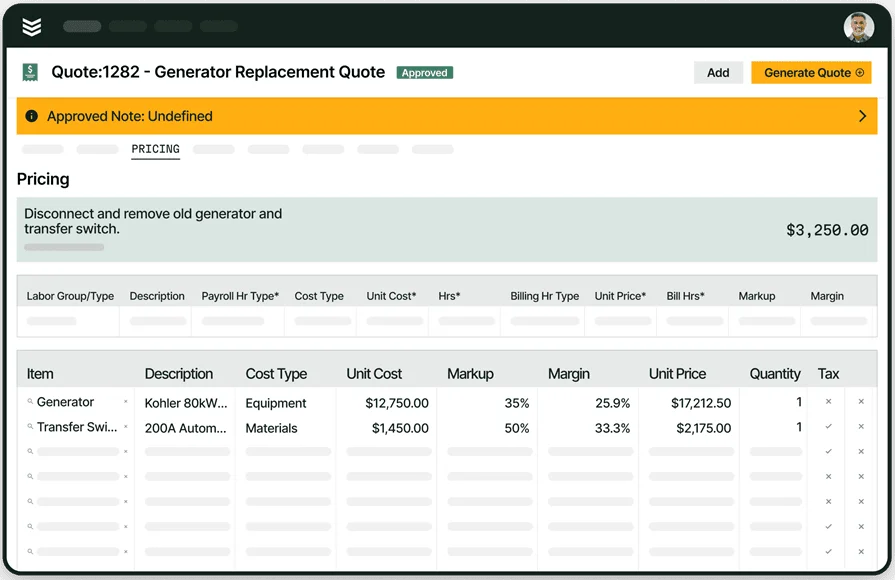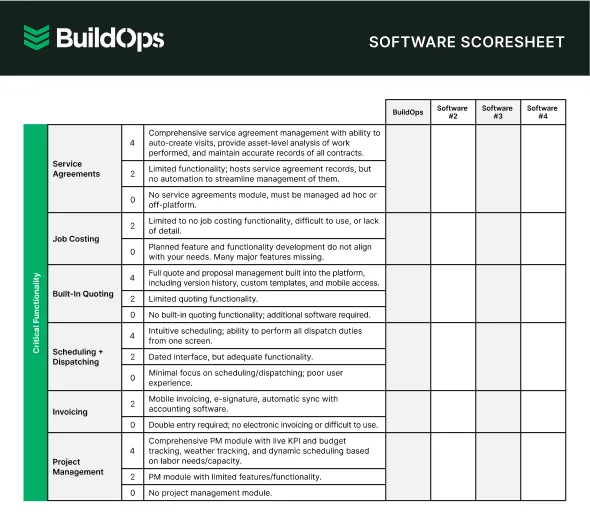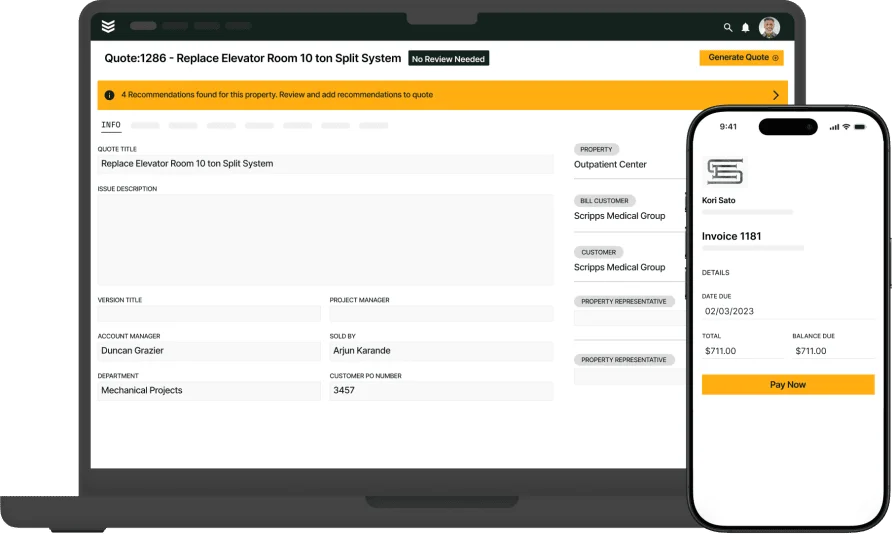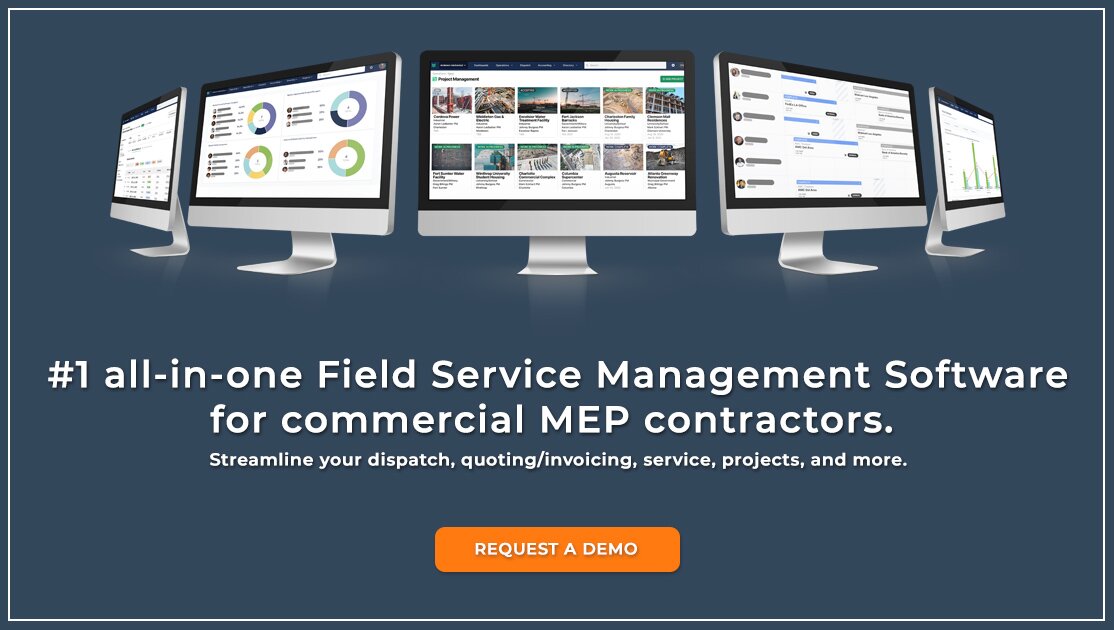If you're a subcontractor bidding on projects, getting your estimates right can make or break your business. Underquote and you cut into profits. Overquote and you lose the job. Relying on spreadsheets or pen-and-paper leaves too much room for costly mistakes, delays, and frustration. That’s where subcontractor estimating software steps in.
Good estimating software helps you calculate labor, materials, equipment rentals, subs, overhead, and margins with pinpoint accuracy. It keeps you competitive, professional, and profitable. Whether you're pricing HVAC installs, plumbing jobs, electrical builds, or fire protection projects, subcontractor estimating software keeps your numbers sharp and your bids on track. Plus, many platforms connect directly with field service management tools, keeping your estimates tied into scheduling, invoicing, and job tracking without added headaches.
In this guide, we’ll break down everything subcontractors need to know when choosing an estimating platform that works for their business:
- Choosing the right subcontractor estimating software for your business
- 6 key features every subcontractor estimating software should have
- 5 best subcontractor estimating software tools & platforms
- 7 benefits of using estimating software for subcontractors
- 4 important subcontractor estimating software FAQs answered
Selecting the right software requires careful consideration. The ideal features vary based on your specific trade, the scale of your projects, and your team's workflow in the field. Before diving into the software features, let’s start with what you should consider when picking the best subcontractor estimating software for your business.
Choosing the right subcontractor estimating software for your business
For subcontractors working in the field, estimating kicks off every job. Whether it's HVAC installs, plumbing runs, electrical layouts, or fire protection builds, one bad estimate can wreck your schedule and profit. Crews count on solid numbers to plan labor, order materials, and hit deadlines without bleeding money. Subcontractor estimating software helps nail those numbers so your techs walk into every job knowing what’s needed — and exactly what it costs.
The platform needs to match how your team works, speed up bidding, and deliver reliable estimates every time. Before committing to a solution, here’s what to focus on:
- Ease of use – How quickly can estimators create bids without spending days learning the system? Is the interface simple enough for project managers and field techs to update from the jobsite? Can they drag and drop materials, adjust quantities, and build quotes while walking a project?
- Pricing flexibility – Can labor rates be adjusted for shift work, trade specialties, or union wages? Does it allow real-time material price updates from your vendors? Can markups shift depending on project type and profit goals?
- Integration with your other tools – Does the software connect directly with your accounting system, job costing, and field service management tools? Can estimates turn into work orders without double entry? Does it pull previous job data to help fine-tune future bids?
- Mobility and access – Can field teams, project managers, and office staff access estimates on any device? Does it allow real-time updates when changes hit mid-project? Can revisions get made instantly to avoid downtime?
- Features – Does the subcontractor estimating software handle automatic labor and material calculations? Are there pre-built templates for repeat work? Can you attach site photos, blueprints, and supplier quotes right into the estimate? Do the reports give you clean, professional bids ready for submission?
The subcontractor estimating software you use needs to match how your crews work — fast, accurate, and ready to adapt. Up next, we’ll break down the features that help subcontractors build stronger estimates without slowing the job down.
6 key features every subcontractor estimating software should have
Every field job starts long before boots hit the site. For subcontractors handling HVAC, electrical, plumbing, fire protection, or specialty trades, the estimating stage sets the pace for everything that follows. When the estimate is tight, the rest of the job flows smoother—materials show up on time, crews stay on schedule, billing stays clean, and cash keeps moving.
That’s why solid subcontractor estimating software doesn’t just crunch numbers. It connects your entire field operation, from bidding to billing, into one system built to keep your team moving without missing a beat. Let’s break down the features that make the biggest difference out in the field.
1. Invoicing and payments automation
Getting paid starts with an estimate. The best subcontractor estimating software flows directly into your invoicing and payment systems without requiring double entry or separate systems. When the work wraps, the system pulls the estimate details directly into the invoice, updates any change orders, and pushes it out to the customer for fast approval and payment.
Say a plumbing subcontractor wraps up a rough-in for a multi-unit build. Instead of manually creating an invoice back at the office, the software pulls all labor, parts, and equipment directly from the original estimate and generates a bill before the tech even leaves the site. The faster you invoice, the faster the cash hits your account.
2. Job scheduling coordination
Subcontractor estimating software works hand-in-hand with job scheduling tools to line up crews once the bid is approved. Every estimate includes labor hours, trade specialties, and equipment needs, making it simple to assign jobs without creating conflicts or bottlenecks in your calendar.
For example, after landing a contract to handle ductwork installation on a commercial site, your scheduler sees exactly how many crew hours are needed. With the software syncing directly from the estimate, you can slot in your sheet metal crew without guessing or overbooking.
3. Real-time dispatch and field adjustments
Jobs rarely go exactly as planned. By connecting with dispatching tools, subcontractor estimating software allows you to adapt on the fly. Field supervisors and office teams can adjust crew assignments, reschedule delays, or shift timelines based on current jobsite conditions—all while keeping estimates and costs updated.
Let’s say unexpected rain delays push back an outdoor electrical trenching job. Instead of scrambling, your office dispatch updates the crew schedule in real time, and the estimating system adjusts labor hours and dates automatically, keeping your job costing accurate without extra admin work.
4. CRM integration for accurate client data
Accurate estimates require accurate customer data. When your subcontractor estimating software integrates with CRM tools, all client info—site details, job history, contacts, and contract terms—stays tied to every estimate. This keeps proposals sharp and avoids missing key job details.
For instance, an HVAC subcontractor quoting a recurring maintenance contract pulls up past work orders, equipment specs, and service history with one click. The estimator includes all units on-site, recommended service intervals, and pricing structures—all pulled directly from CRM data, reducing missed line items.
5. Technician mobile access
Your field team needs to stay connected while building estimates on-site. With mobile access tied into your technician mobile app, estimators and supervisors can walk the jobsite, input labor counts, materials, and measurements directly into the estimate, and sync it back to the office instantly.
Take a subcontractor walking a retrofit fire sprinkler install. As measurements are taken and pipe runs are counted, the estimator updates the bid live on their tablet. There’s no need to jot down numbers for later entry. The completed estimate gets submitted before even leaving the building.
6. Reporting and profit tracking
At the end of every job, you need to know if the numbers held up. The best subcontractor estimating software connects directly with reporting tools to track job costing, margins, and estimate accuracy over time. This helps sharpen future bids and protects profitability on every project.
Picture a subcontractor reviewing last quarter’s project pipeline. By running profit reports tied back to original estimates, it’s clear where labor overruns happened or material costs blew past projections. This data feeds directly into tighter future bids that protect your bottom line.

Quote projects precisely
Estimate jobs accurately, minimizing unforeseen costs and increasing profitability.
Other notable features for subcontractor estimating software
While the core features handle the heavy lifting, several additional tools help subcontractors run tighter, smoother estimating processes. These features aren’t always mission-critical, but they can add extra value, save time, and help subcontractors keep control of their jobs from estimate to closeout.
- Time tracking integration – Syncs labor hours directly from the field using time tracking tools, ensuring estimates match actual job performance while simplifying payroll and job costing.
- Pipeline management – Organizes upcoming bids, proposals, and opportunities through a dedicated sales pipeline tool, helping subcontractors prioritize which projects to estimate and pursue based on workload and revenue goals.
- Fleet tracking and management – Ties vehicle usage directly into job planning with fleet tracking software, allowing subcontractors to monitor vehicle location, fuel use, and service needs tied to specific job estimates and schedules.
- Service agreement management – Supports recurring work contracts using service agreement features, making it easy to bundle long-term service estimates into maintenance contracts for ongoing clients.

Easily compare software providers
Compare options side-by-side and see which platform fits your crew.
While these added features give subcontractors extra tools to run leaner operations, it all starts with having the strongest estimating platform in place. Let’s look at some of the best subcontractor estimating software options built to handle the demands of field service work.
5 best subcontractor estimating software tools & platforms
Every subcontractor runs into the same challenge: you only get one shot at pricing a job right. The estimating software you use needs to reflect the real conditions your crew faces out in the field. Whether you’re managing HVAC installs, electrical work, plumbing, or specialty trades, the right subcontractor estimating software helps you build accurate quotes, lock in profits, and keep field operations running smoothly from bid to closeout.
Here’s a closer look at some of the top software options subcontractors are using to stay competitive.
1. Best for commercial subcontractors: BuildOps
BuildOps is built for subcontractors handling large-scale commercial field service projects. It provides an all-in-one solution where estimates automatically flow into scheduling, invoicing, dispatching, and job management. Subcontractors can create highly detailed bids with real-time labor, material, and equipment costs, while the software keeps everything synced across departments for smooth handoffs from estimating to project execution.
How pricing works: BuildOps uses a customized pricing model based on subcontractor size and operational needs, so you're only paying for features that directly support your estimating, field service, and job management workflows.
Features beyond estimating:
- Real-time cost tracking and job costing
- Automated labor and material calculations
- Seamless integration with scheduling, dispatch, and invoicing
What sets it apart for subcontractors: BuildOps stands out by connecting estimating directly to every field service task subcontractors deal with daily. From live cost tracking to multi-crew scheduling and service coordination, it gives subcontractors a real-time command center that simplifies both quoting and job execution.

Give BuildOps a Try
We help teams estimate, schedule, invoice, and execute projects with confidence.
2. Best for residential subcontractors: Housecall Pro
Image Source: Housecall Pro
Housecall Pro offers residential subcontractors an easy-to-use platform that handles estimating, scheduling, invoicing, and customer management. Its mobile-first interface allows field technicians and office staff to generate quotes and convert them into jobs quickly, making it ideal for smaller residential subcontractors who need estimating tools tied directly to job execution. However, subcontractors managing commercial projects or complex multi-trade bids may find Housecall Pro lacking the advanced job costing, reporting, and customization needed for larger operations.
How pricing works: Housecall Pro follows a tiered pricing model, allowing subcontractors to select a plan that fits the size of their business and level of features required.
Features beyond estimating:
- Built-in scheduling and dispatching tools
- CRM features for customer management
- Mobile app for field quoting and client communications
What sets it apart for subcontractors: Housecall Pro keeps things simple for residential subcontractors handling everyday installs and service work. It allows subcontractors to build quick estimates, manage appointments, and handle customer payments directly from the field.
3. Best for general subcontractors: Jobber
Image Source: Jobber
Jobber gives general subcontractors an approachable platform for managing estimating, job scheduling, invoicing, and client management. Its simple interface allows subcontractors to create estimates quickly, track job progress, and stay organized through one dashboard. Smaller subcontractors benefit from Jobber’s mobile tools that let field teams update estimates and job status in real-time. That said, subcontractors managing multiple trades, complex bids, or large-scale field operations may find Jobber’s estimating tools too basic for commercial subcontractor needs.
How pricing works: Jobber offers three pricing tiers with different feature sets, allowing subcontractors to select the plan that best fits their operational complexity and growth stage.
Features beyond estimating:
- Quick and accurate quote creation
- Real-time job tracking and task management
- Mobile app for field and office sync
What sets it apart for subcontractors: Jobber helps subcontractors run day-to-day estimating and job management with minimal admin time. For small crews handling short turnaround projects, its mobile access and task tracking keep jobs moving efficiently.
4. Best for subcontractor field coordination: Fieldwire
Image Source: Fieldwire
Fieldwire offers subcontractors a strong solution for managing jobsite coordination while supporting estimating tasks with real-world field inputs. Subcontractors can use Fieldwire to create task lists, track work progress, record site conditions, and sync field data that feeds back into estimates for future jobs. While it’s not a full estimating platform on its own, its field management features help subcontractors build better data for more accurate future bids. Subcontractors looking for fully integrated estimating, invoicing, and financial management may find Fieldwire limited as a standalone estimating solution.
How pricing works: Fieldwire operates on a subscription-based pricing model with multiple tiers depending on company size, feature needs, and user count.
Features beyond estimating:
- Real-time task management for field teams
- Site documentation with photos, plans, and daily reports
- Crew scheduling and resource allocation
What sets it apart for subcontractors: Fieldwire helps subcontractors connect their field operations directly to the estimating process by capturing real-time site data, labor productivity, and job progress for better-informed estimates down the line.
5. Best for subcontractor project management: Procore
Image Source: Procore
Procore delivers subcontractors an end-to-end construction management platform with estimating capabilities tied into project budgets, contracts, and schedules. Subcontractors can create estimates, track commitments, manage subcontractor quotes, and control costs across projects. Its strong project management foundation helps subcontractors stay organized across large, complex builds. However, subcontractors focused purely on field service estimating or fast-turnaround quoting may find Procore’s depth better suited for larger general contractors or major subcontractors with complex project pipelines.
How pricing works: Procore offers custom pricing based on company size, project volume, and modules selected, with flexible packages for subcontractors managing multiple ongoing projects.
Features beyond estimating:
- Complete budget tracking and change management
- Subcontractor contract management tools
- Integrated document control, RFIs, and field reporting
What sets it apart for subcontractors: Procore helps subcontractors manage both estimating and job delivery through one centralized platform, allowing teams to control financials, field communication, and project timelines from a single system.
7 benefits of using estimating software for subcontractors
Subcontractors deal with tight margins, unpredictable jobsite conditions, and constant shifts in scope. Every bid sets the tone for whether a job stays profitable or turns into a mess of overruns. Subcontractor estimating software helps control that risk by delivering accurate numbers from the start, while keeping field and office teams aligned through every phase of the job. Here’s how the right software makes a real difference in daily subcontractor operations.
1. Faster job approvals and client sign-offs
When estimates are accurate, clear, and detailed, clients approve them faster. Subcontractor estimating software allows you to build professional quotes that include every material, labor hour, and subcontractor cost upfront—reducing questions and back-and-forth with GCs or owners.
2. Fewer scheduling conflicts and tighter crew management
Accurate estimates feed directly into scheduling, making it easier to assign the right number of crews to each job. With better data on labor hours and equipment needs, subcontractors can avoid overbooking or idle time, while ensuring each crew hits the ground fully prepared. Tools like subcontractor scheduling apps help subcontractors keep schedules synced directly to what’s been estimated, avoiding costly overlaps or gaps.
3. Improved job costing accuracy throughout the project
By building estimates directly from real-world field data, subcontractor estimating software helps track actual costs against projected ones as work progresses. This real-time visibility into labor, materials, and subcontractor costs makes it easier to identify overruns before they become problems.
4. Better financial tracking with field service metrics and KPIs
Beyond just estimating upfront costs, subcontractor estimating software supports ongoing financial health by feeding accurate data into your field metrics. When connected to field service metrics and KPIs, subcontractors can monitor profitability, labor productivity, and material usage as each job unfolds, helping spot trouble early and course correct.
5. Stronger reporting for tighter project control
With reporting tied directly to estimates, subcontractors gain clearer visibility into which bids are performing well and where adjustments are needed. Field service reporting tools pull estimate data into easy-to-read dashboards that help subcontractors monitor trends, costs, and margin risks over time.
6. Centralized dashboards for estimating oversight
Subcontractors managing multiple bids or juggling several projects benefit from having all estimates tied into a single platform. Field service dashboards allow subcontractors to review active bids, monitor pending approvals, and spot workload bottlenecks—ensuring estimating stays consistent even across a busy pipeline.
7. Seamless handoff from estimate to dispatch
Once a job is awarded, subcontractor estimating software integrates with dispatching to keep crews and materials moving. The labor, equipment, and timing built into each estimate help dispatch teams create daily assignments without needing to rebuild schedules from scratch. Subcontractors who follow field service dispatching best practices can quickly turn approved estimates into executable job schedules without missed details or delays.
4 important subcontractor estimating software FAQs answered
Subcontractors deal with more than just estimating—they balance jobsite work, crew scheduling, material orders, client expectations, and billing. That’s why understanding how subcontractor estimating software works is so important. Whether you're new to estimating software or looking for better tools to manage your field service projects, these answers cover what subcontractors need to know before committing to any platform.
1. What is subcontractor estimating software?
Subcontractor estimating software gives field service subcontractors and their teams the ability to build fast, accurate estimates by automatically calculating labor, materials, equipment, contractor costs, overhead, markups, and profit, while generating professional, client-ready proposals.
In addition to building quotes, many systems connect with dispatching, invoicing, scheduling, and job management tools. This allows subcontractors to manage projects from bid to completion without duplicate data entry or manual tracking.
2. How does subcontractor estimating software work?
Subcontractor estimating software uses built-in templates, databases, and automation to calculate total project costs. Estimators input job details like crew hours, material quantities, site conditions, equipment rentals, and subcontractor pricing. The software calculates totals instantly and adjusts pricing based on supplier updates, field conditions, or scope changes—all while keeping the estimate tied into your job management system.
3. Who should use subcontractor estimating software?
Any subcontractor performing field service work across HVAC, plumbing, electrical, fire protection, or specialty trades can benefit. If you’re still quoting jobs manually, chasing down pricing updates, or reworking bids mid-project, subcontractor estimating software helps reduce estimating time, improve consistency, and prevent costly mistakes.
4. What are some best practices for using subcontractor estimating software?
To get the full value from subcontractor estimating software, field teams and office staff should follow proven best practices that tie estimating directly into your daily operations:
- Build a cost database using your historical job data
- Keep labor rates updated to match crew experience and market wages
- Sync supplier pricing to reflect real-time material costs
- Create reusable estimate templates for your most common service jobs
- Link estimates directly to your scheduling and dispatch systems
- Assign estimators to walk complex jobsites for more accurate field inputs
- Integrate estimates with job costing for live profit tracking
- Use reporting tools to analyze estimate accuracy over time
- Set up mobile access so supervisors can update estimates from the field
- Review finalized estimates with project managers before approval
When subcontractors handle estimates with confidence, everything else in the field runs smoother. But estimating software only solves part of the equation. Managing the full scope of field service—crew scheduling, dispatch, invoicing, job costing, and customer communication—requires one platform that keeps every moving piece connected. That’s where an all-in-one field service subcontractor solution like BuildOps can give commercial subcontractors the tools they need to keep estimates accurate, crews productive, and projects profitable from start to finish.

See how it works in real time
We help subcontractors simplify estimating while managing the entire job.







